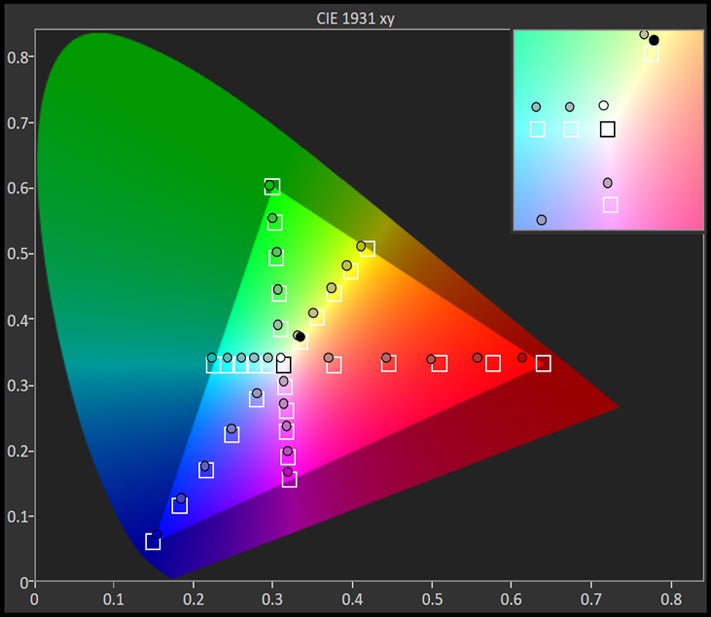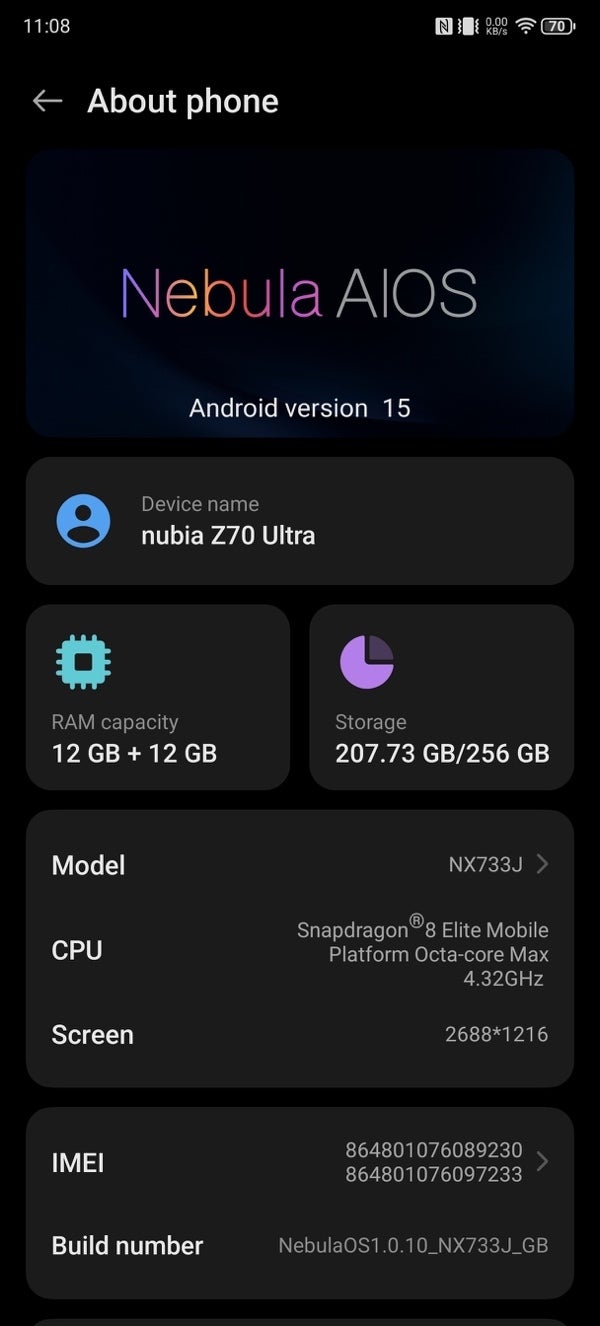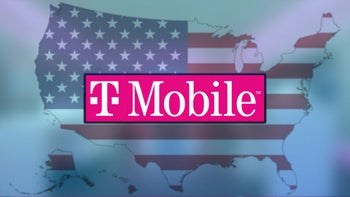Nubia Z70 Ultra review: A value-packed flagship with cutting-edge performance

Nubia Z70 Ultra Intro
What does it take to stand out in today's overpopulated phone market?
A distinct exterior design? A camera with variable aperture? The first 3nm Snapdragon chip available for Android phones? Customizable extra buttons? A $729 starting price tag with availability in the US?
The new Nubia Z70 Ultra checks all of those boxes. See, if life has taught us anything, it's that when something seems too good to be true, it usually is, but there are always some exceptions to the proverbial rule. Could the Nubia Z70 Ultra be just that, a superb value-for-money exception that does everything right and doesn't cost an arm and a leg?
Let's answer all those questions!
Table of Contents:
Nubia Z70 Ultra Specs
A specs monster
Here's a summary of the Nubia Z70 Ultra specs:
| Specs | PHONENAME |
|---|---|
| Size and Weight | 164.3 x 77.1 x 8.6 mm, 228gr |
| Display | 6.8-inch AMOLED, 144Hz, 2000 nits of bri |
| Processor | Snapdragon 8 Elite, 3nm |
| Software | Android 15, Nebula OS |
| Cameras | 50MP wide-angle, F1.6-F4.0, 35mm 50MP ultra-wide, F1,8, 13mm 64MP telephoto, F2.5, 70mm 16MP under-screen |
| Battery Size | 6150mAh Si-carbon |
| Charging Speeds | 80W wired charge No wireless charging |
| Prices | $729 for 12GB/256GB $829 for 16GB/512GB $949 for 24GB/1TB |
Nubia Z70 Ultra Design and Display
An all-screen phone with a head-turning camera layout
The Nubia Z70 Ultra is a phone that definitely stands out. It is a solid phone, with an unmistakable and unique rear design, which kind of reminds us of the quirky point-and-shoot cameras from more than a decade ago. That's courtesy of the large camera assembly at the rear, which relies on a staggered camera design, bold colors, and two contrasting glass panels to stand out.
The rest of the phone employs a standard flat design. The satin-like aluminum frame is mostly flat but has minuscule chamfers just around the corners, which gives off a premium feel and makes this Nubia feel great in the hand.
Oh, and here's yet another reason why the Nubia Z70 Ultra looks just like a camera: it has a tiny two-step shutter button, positioned at the lower right part of the side frame. This button lets you quickly open the camera from anywhere, as well as focus and capture a photo or a burst of photos.
There's also a hardware switch button positioned high up on the left side of the phone. That one is customizable, allowing you to access some core features like the camera, flashlight, or the voice recorder, but the most useful feature is the ability to switch between sound modes, like you used to do on iPhones with a physical ringer switch.
There's also an IR blaster at the top of the phone. That's still a wildly popular feature on phones mainly intended for the local Chinese market, though it has essentially disappeared in the West. It doesn't hurt to have it on board, though: it's more convenient to use your phone instead of several bulky remotes.
The Nubia Z70 Ultra is a fairly large phone, but it doesn't feel overly bulky or uncomfortable to use. In fact, it feels solid in a good way, with reassuring weight and shape that makes handling it a pleasant experience.
The phone boasts both IP68 and IP69 water and dust-certification, which means that it's not only impervious to submerging in up to 1.5m of freshwater for up to 30 minutes, but it can also survive high-pressure and high-temperature (up to 80ºC) water jets. This makes the phone virtually waterproof, and Nubia has made good use of that: the camera has a dedicated underwater shooting mode.

Unboxing the Nubia Z70 Ultra is pure joy (Image by PhoneArena)
Inside the Nubia Z70 Ultra box, you'll find the phone itself, the usual manual and leaflets, a very decent silicone case, as well as an 80W wall adapter and USB-C cable. Kudos where kudos is due, that's great value, and way more than most other manufacturers will give you these days.
The display at the front is a 6.85-inch AMOLED that supports up to 144Hz of smooth refresh rate. To be honest, it's already challenging to notice any difference past 120Hz on a phone, but hey, if the numbers go up, we can't be mad.

Look, ma, no punch-hole! (Image by PhoneArena)
What you'll definitely notice with the Nubia Z70 Ultra is the uninterrupted viewing area. Yes, this phone has a selfie camera hidden under the screen, so no unsightly punch-hole here that will get in the way of your YouTube videos or TV shows.
At 20% APL (just 20% of the screen is displaying a fully white image), the Nubia Z70 Ultra achieves a pretty high max brightness of 1,845 nits, ranking lower than rivals like the Pixel 9 Pro XL and the Galaxy S24 Ultra.

There are plenty of screen-related settings available (Image by PhoneArena)
However, at 100% APL where the whole screen is displaying a white image, the Nubia actually beats the Galaxy by a couple of hundred nits. The only thing we don't really like here is the minimum brightness––it's 3.4 nits, which is pretty high.
Moving on to the color rendition, it's pretty good. The Nubia has a nearly perfect default color temperature, gamma, and color accuracy. Gray colors have an ever-so-slight yellow-ish tint to them, but you won't notice that outside of a color calibration test.
Display Measurements:
In terms of biometrics, the Nubia Z70 Ultra boasts an under-display optical fingerprint reader. It works just fine, however, it's noticeably slower to react than ultrasonic fingerprint scanners, and occasionally, your fingerprint might not be registered on the first try. Other than that, it's perfectly okay.
Nubia Z70 Ultra Camera
Definitely a mixed bag of good and bad

With a camera setup looking like this, we were expecting more (Image by PhoneArena)
The Nubia Z70 Ultra introduces several notable changes compared to its predecessor, the Nubia Z60 Ultra. One key upgrade is the main camera, which now features a variable aperture ranging from F1.6 to F4.0, but this functionality is limited to the dedicated Pro and Street camera mode. In regular camera mode, the aperture remains fixed at its widest setting (F1.6), even in well-lit conditions.
The telephoto camera has a slightly reduced native optical zoom, offering a 70mm (2X) zoom compared to the 85mm (2.4X) zoom on the Z60 Ultra. While you can still capture images at the longer focal length, it now relies on digital rather than purely optical zoom.
The telephoto camera has a slightly reduced native optical zoom, offering a 70mm (2X) zoom compared to the 85mm (2.4X) zoom on the Z60 Ultra. While you can still capture images at the longer focal length, it now relies on digital rather than purely optical zoom.
The ultra-wide camera has also been upgraded with a 13mm lens, providing a 122-degree field of view. It can shoot at tighter focal lengths of 18mm and 24mm, but the image quality at these focal lengths falls short of our expectations.
On the front, there’s a 16MP under-display camera, seamlessly blending into the screen. However, its image quality is mostly underwhelming.
In terms of software, the camera app is packed with features, though many of the included shooting modes feel gimmicky (like the underwater camera mode). The Pro camera mode is good, though. The interface is unintuitive, particularly when switching between zoom levels and focal lengths, which can make the user experience more confusing than convenient.
The Nubia Z70 Ultra went through the paces of our PhoneArena Camera test, which evaluates both the still photo and video-recording capabilities of the tested device, and it didn't perform as good as we had hoped, somewhat disappointing us in the process. You can check out how other devices have fared in this test in our Camera Score database.
The image quality is a mixed bag. Sure, the main and telephoto cameras deliver lots of detail and good colors, but the dynamics are mostly lacking, and zooming in on a photo will regularly showcase some oversharpening artifacts, which aren't a good thing to see on a late-2024 flagship. All cameras tend to under-expose the scene, and the dynamics aren't great most of the time, with crushed shadows and blown highlights galore. The same is true with for the ultra-wide camera, too.
The front-facing camera is mostly okay once you factor in the fact that it's tucked under the display. Sure, finer details are non-existent, and most selfies you take will turn to watercolor paintings as soon as you zoom in a little, but when taken in good lighting, the photos are usable.
Video Quality

Videos taken with the Nubia are pretty mediocre. The dynamics range isn't ideal, resulting in overblown highlights and crushed shadows in many scenarios. There are lots of oversharpening artifacts, and when the light is not ideal, severe noise, especially when using the dedicated telephoto zoom. The recorded audio isn't great, either.
Nubia Z70 Ultra Performance & Benchmarks
Do we even deserve so much power?

Don't judge, Minecraft is life (Image by PhoneArena)
It's none other than the Snapdragon 8 Elite that's powering the Nubia Z70 Elite. Qualcomm's first 3nm mobile chip that's available to Android manufacturers is definitely a powerhouse that provides us with access to more raw power than we can realistically use.
The phone is available in three different storage configurations: 12GB RAM with 256GB of storage, 16GB RAM with 512GB of storage, and the top-of-the-line 1TB version with 24GB of physical RAM. Aside from that, you can also allocate a portion of the storage to act as RAM; on our 12GB unit, you can allocate 12GB of RAM extra.
Performance Benchmarks:
In real life, the Nubia Z70 Ultra is extremely snappy and has loads of power in reserve. It never feels as if the phone is struggling with any task, be it quick multitasking or playing an intensive 3D game.
Our in-house benchmarks confirm that. The Nubia Z70 Ultra loses to the Apple's second-gen 3nm chip inside the iPhone 16 Pro Max in our Geekbench 6 single-core test, but aces the multi-core one. In fact, it easily beats the most popular Android devices in the face of the Galaxy S24 Ultra or the Pixel 9 Pro XL.
The same is true of the 3DMark Extreme gaming test, which makes it clear that the Snapdragon 8 Elite is a top performer when it comes to gaming. The "low" score easily surpasses the iPhone 16 Pro Max by a very long shot, which means that even at its worst, the Nubia Z70 Ultra will still run circles around Apple's finest. The "high" score, on the other hand, represents the initial burst of gaming performance with no throttling, where the Nubia Z70 Ultra and the Snapdragon 8 Elite are definitely in a league of their own.
The same is true of the 3DMark Extreme gaming test, which makes it clear that the Snapdragon 8 Elite is a top performer when it comes to gaming. The "low" score easily surpasses the iPhone 16 Pro Max by a very long shot, which means that even at its worst, the Nubia Z70 Ultra will still run circles around Apple's finest. The "high" score, on the other hand, represents the initial burst of gaming performance with no throttling, where the Nubia Z70 Ultra and the Snapdragon 8 Elite are definitely in a league of their own.
Thermal management is excellent on this phone. The phone does get a little warm after a long gaming session (15–20 minutes), but never too hot, and frame rates stay consistent. Great job!
Nubia Z70 Ultra Software
The Nubia Z70 Ultra comes along with Android 15 and the company's own Nebula OS running on top. It's a very lightweight and straightforward custom Android skin, without any extra fluff aside from the base Android features and a few useful extras sprinkled on top.
There are loads of visual and functional customization settings that let you fine-tune the user interface. It's intuitive and logical to get around Nebula OS, and although it has some minor quirks, it's not a bad user interface by any means. What I like about it, however, is the lack of any bloatware: the phone comes with just a few core apps pre-installed, which is great. Aside from a stock browser, phone app, and a file manager, you're only getting the base suite of Google apps.
In terms of AI (the leitmotif of this decade, it seems), the Nubia Z70 Ultra doesn't have many of these on board. There's the AI Translate feature, which provides real-time translation during phone calls, and… two other features that don't really utilize AI, an interface sidebar and a 5G signal booster. We can't say we are disappointed with the lack of fluff AI features.
Of course, Gemini AI is just a power button press away.
Nubia says that the Z70 Ultra will get three years of software updates, including a major upgrade to Android 16, whenever that one lands.
Nubia Z70 Ultra Battery
Great, but with some room for improvement
The Nubia Z70 Ultra comes with a truly massive 6,150mAh silicon-carbon battery; those offer much greater energy density than standard lithium-ion batteries. That's just 150mAh more than the Nubia Z60 Ultra, but we are not complaining at all, especially considering that most of the Nubia's competitors arrive with significantly smaller batteries. For example, Samsung has been stuck in the 5,000mAh rut for half a decade now, with seemingly no plans to offer a larger battery on its Ultra flagships anytime soon.
How does the Snapdragon 8 Elite pair with the Nubia's 6,150mAh battery? In our own battery tests, which are all conducted with the displays manually set at 200 nits of brightness, the phone performs admirably and delivers excellent battery backup. In our web browsing test, which simulates a casual browsing experience, the phone lasts for nearly 20 hours.
However, where it truly shines is our video streaming test, where it beats all of its rivals with a super-solid result of 12 hours and 49 minutes of video playback. Finally, in our 3D gaming test, it lasted for 13 hours and 29 minutes, just a half an hour less than the Galaxy S24 Ultra.
PhoneArena Battery Test Results:
In real life, it's mostly safe to say that this is a two-day phone with regular use. Heavy users and gamers should probably expect something closer to a one-day phone, but as usual, your mileage will vary.

A look at the Nubia Z70 Ultra's USB-C port (Image by PhoneArena)
In terms of charging, the phone supports 80W wired charging, and you get a wall adapter in the box along with the phone, which is great news. The phone takes 44 minutes to fully charge with its stock charger. A large part of this is trickling, though, as a 30-minute charge will net you 75% of battery charge, which should be enough for a full day of intensive use.
PhoneArena Charging Test Results:
The Nubia Z70 Ultra doesn't support wireless charging.
Nubia Z70 Ultra Audio Quality and Haptics
The Nubia Z70 Ultra has stereo speakers, but the audio quality is average at best. The maximum volume is relatively low, yet there is still noticeable distortion at higher volume levels––not good. The speakers always sound like they are suffering and torturing themselves.
The sound stage is tiny, the bass is mediocre, and the overall audio experience isn't particularly enticing. There's a DTS setting with various equalizer presets, but tinkering with those doesn't improve the experience. An iPhone or a Galaxy deliver a significantly more enjoyable experience.
In terms of haptic feedback, the vibrator on the phone feels precise, but a bit too weak and tinny. It lacks the characteristic strong rumble that an iPhone or a Galaxy will get you, instead you get a high-pitched vibration that does not feel particularly nice.
Should you buy it?

It's a decent phone overall (Image by PhoneArena)
Well, the Nubia Z70 Ultra is a mixed bag of a phone––it has many strengths, but some weaknesses, too.
Starting at $729, it's excellent value when you factor in the 3nm Snapdragon 8 Elite chip on board. Although phones with the latest Qualcomm chip are still difficult to come by and will only become prevalent in 2025, we doubt you will be able to get a more affordable phone with the 3nm Snapdragon chip in the US. So, if you're carefully calculating your "performance per dollar" gained, few phones can match the Nubia Z70 Ultra at the moment.
The intriguing design, great battery life, and splendid screen are also some aspects of this Android exotic that go into the "strengths" column.
However, it can't be all good, and it's normal that some corners have been cut to achieve the overall value proposition. The camera has some issues and isn't on the same level as most flagships sold in the US. The audio quality is average. The interface is okay, but uninspiring in comparison with its competitors. Still, minor issues in the grand scheme of things, but be aware of those.
Some potential alternatives you might want to wait for are the OnePlus 13 and the Galaxy S25 Ultra, which should be out in early January 2025. Both will be powered by the same chip and will most likely deliver a better experience in all those areas where the Nubia Z70 Ultra has dropped the ball.
The Nubia Z70 Ultra feels like a phone for budget-conscious buyers that still want to ride the latest tech wave. That's perfectly fine, as far as they are aware of the underwater rocks that sometimes might make the journey unpleasant.




























Things that are NOT allowed: